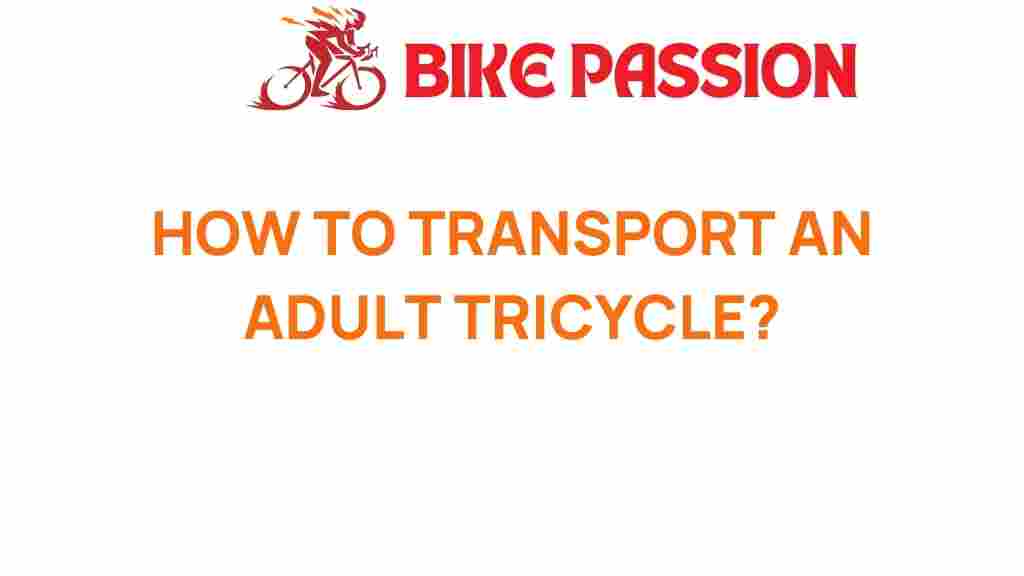Mastering the Art of Adult Tricycle Transportation
As the world becomes more focused on sustainable living and personal mobility, adult tricycles have emerged as a popular choice for transportation. They offer stability, comfort, and a unique riding experience that appeals to a broad audience. In this comprehensive guide, we’ll explore effective tips and tricks for using adult tricycles, covering everything from selecting the right gear to ensuring your safety on the road. Whether you’re a seasoned rider or a newbie, you’ll find valuable insights to master the art of adult tricycle transportation.
Understanding Adult Tricycles
Adult tricycles are designed specifically for adults, combining the benefits of cycling with added stability. They’re perfect for those who may have balance issues or simply prefer a more secure riding experience. Here are a few types of adult tricycles you might consider:
- Standard Adult Tricycles: These are the traditional three-wheeled bicycles that offer a comfortable seat and a stable ride.
- Electric Adult Tricycles: Equipped with a motor, these tricycles provide an extra boost for easier riding, especially uphill.
- Folding Adult Tricycles: Designed for easy storage and transport, these trikes can be folded down when not in use.
Choosing the Right Adult Tricycle
When selecting the best adult tricycle for your needs, consider the following:
- Purpose: Will you be using it for commuting, leisure, or exercise?
- Size: Ensure the tricycle fits your height and weight for maximum comfort.
- Features: Look for features like adjustable seats, storage baskets, and lighting for safety.
Transportation Tips for Adult Tricycles
Once you have your adult tricycle, it’s time to hit the road! Here are some essential transportation tips to enhance your riding experience:
1. Plan Your Route
Before you start riding, plan your route carefully. Here are some considerations:
- Choose bike-friendly roads and paths.
- Avoid busy streets and heavy traffic areas.
- Use a map or GPS to navigate efficiently.
2. Dress Appropriately
Wearing the right gear can significantly impact your comfort and safety:
- Helmet: Always wear a well-fitted helmet to protect yourself in case of falls.
- Clothing: Opt for bright, reflective clothing for visibility, especially during low-light conditions.
- Footwear: Comfortable shoes that provide adequate grip are essential for control.
3. Check Your Equipment
Before you ride, perform a quick check of your tricycle:
- Inspect the tires for proper inflation.
- Ensure the brakes are functioning correctly.
- Check the lights and reflectors if you plan on riding at night.
Best Practices for Adult Tricycle Riding
To master the art of riding an adult tricycle, incorporating best practices into your routine can make a significant difference:
1. Maintain Proper Posture
Good posture while riding can prevent discomfort and injuries:
- Keep your back straight and shoulders relaxed.
- Grip the handlebars lightly without tension.
- Keep your elbows slightly bent for better control.
2. Use Your Gears Wisely
Understanding how to use your gears can enhance your riding experience:
- Shift to a lower gear when climbing hills.
- Use higher gears for flat surfaces to maintain speed.
3. Practice Braking Techniques
Effective braking is crucial for safety:
- Use both brakes evenly to avoid tipping.
- Start braking early when approaching stops.
Safety Measures for Adult Tricycles
Safety should always be a priority when riding an adult tricycle. Here are some crucial safety measures to follow:
1. Be Aware of Your Surroundings
Stay alert and be aware of pedestrians, vehicles, and other cyclists:
- Use hand signals to indicate turns and stops.
- Make eye contact with drivers when crossing intersections.
2. Follow Traffic Rules
Tricycles are often treated like bicycles in traffic:
- Obey all traffic signals and signs.
- Ride in the same direction as traffic.
3. Use Night Riding Gear
If you plan to ride at night, equip your tricycle with proper lighting:
- Install front and rear lights.
- Add reflectors to increase visibility.
Troubleshooting Common Issues
Like any mode of transportation, adult tricycles can face issues. Here are some common problems and how to address them:
1. Flat Tires
A flat tire can happen unexpectedly. Here’s how to handle it:
- Carry a patch kit and pump with you.
- Learn how to change a tire if you’re away from home.
2. Brake Issues
If your brakes feel weak or unresponsive:
- Check the brake pads for wear.
- Adjust the brake cables if necessary.
3. Gear Problems
If you’re having trouble shifting gears:
- Inspect the gear cables for fraying.
- Ensure the derailleur is properly aligned.
Conclusion
Mastering the art of adult tricycle transportation requires knowledge, practice, and a commitment to safety. By following the tips and tricks outlined in this guide, you can enjoy a smooth and enjoyable riding experience. Remember to always wear your helmet, plan your routes wisely, and maintain your tricycle regularly. For more information on biking gear and safety practices, check out this helpful resource.
Are you ready to embrace the joy of riding an adult tricycle? Start today and enjoy the freedom and fun that comes with this unique mode of transportation!
For further exploration of different transportation methods, visit this external guide.
This article is in the category Gear and created by BikePassion Team
